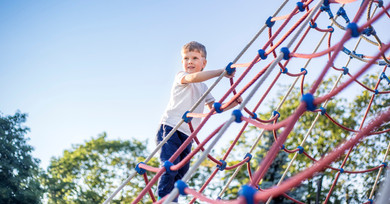Children gravitate toward climbing structures with an enthusiasm that seems almost instinctive. The science behind kids' attraction to climbing activities reveals fascinating insights into child development and natural learning processes.
Understanding these scientific principles helps decision-makers create outdoor spaces that truly serve children's developmental needs. When communities invest in quality climbing equipment, they support essential growth processes that extend far beyond simple recreation.
Physical Development Through Vertical Challenge
Climbing activates multiple muscle groups simultaneously, building strength in ways that few other activities can match. Children develop core stability, grip strength, and coordination as they navigate upward paths.
Their proprioceptive system—the internal sense of body position—receives constant feedback during each climb. This sensory input strengthens neural pathways that support balance and spatial awareness.
Research shows that playgrounds with climbing features enhance fundamental movement skills, including stability, locomotor abilities, and coordination. The physical demands of ascending and descending structures create natural resistance training that is appropriate for growing bodies.
Cognitive Growth and Problem-Solving Skills
Each climbing structure presents a unique puzzle that children must solve through trial and observation. They calculate distances, assess risks, and plan movement sequences before taking action. This decision-making process strengthens executive function skills that transfer to academic settings.
Children learn to break complex challenges into manageable steps as they choose handholds and footholds. The immediate feedback from their environment—whether they successfully reach the next level—reinforces learning through natural consequences. Quality playground parts and accessories provide varied routes and difficulty levels that accommodate different developmental stages.
Emotional Confidence and Risk Assessment
Climbing experiences teach children to evaluate challenges realistically and manage appropriate risks. Successfully reaching the top of a structure builds self-efficacy and confidence in their physical abilities. Children learn to distinguish between productive challenges and genuine dangers through repeated exposure.
This emotional growth proves invaluable as they navigate increasingly complex social and academic situations. The controlled environment of a playground allows them to test personal limits safely while developing resilience. Overcoming vertical challenges creates lasting memories of achievement that shape their self-perception positively.
Bring Science to Your Playground
The science behind kids' attraction to climbing activities demonstrates why these structures remain essential components of quality playgrounds. Children instinctively seek climbing opportunities because their developing brains and bodies require this specific type of engagement.
Communities that prioritize climbing equipment invest in comprehensive child development across physical, cognitive, and emotional domains. Creating spaces where children can safely explore vertical challenges supports healthy growth in measurable, meaningful ways.

